A brave act of inclusion or a misguided stunt? The new graffiti-style art installation inside Canterbury Cathedral has divided opinion, with even the Vice President of the USA wading into the debate. Rebecca Chapman notes that if a Cathedral can’t point people toward gospel truth, then the church is in serious trouble
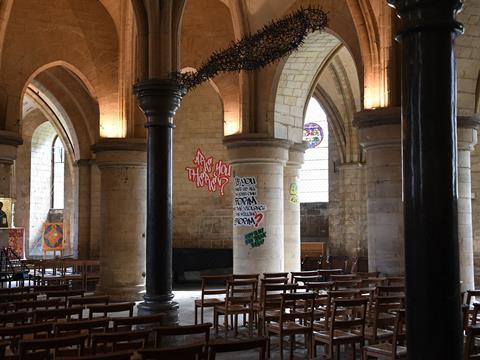
What does it take to make others see the church as radical? Last Friday, the Church of England announced a woman would be the next Archbishop of Canterbury. That caused a few ripples and was seen by some as radical.
Just a week later, the Cathedral where she will have her seat is making much larger waves across social media. Reports emerged of a new art installation at Canterbury Cathedral, with striking images of ‘graffiti style graphics’. One Cathedral visitor compared it to ‘an underground car park’. Was this radical – or appallingly irreverent?
Art for the marginalised
The project, ‘Hear Us’, was the culmination of poet Alex Vellis and curator Jacquiline Creswell’s workshops with marginalised communities (including Punjabi, black and brown diaspora, neurodivergent, and LGBT groups) on the question “What would you ask God?”
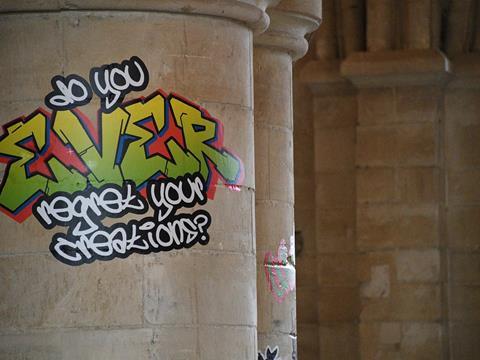
Their collaborative responses are now graffiti-style stickers plastered across the Cathedral. Questions such as “Why did you create hate when love is by far more powerful?”; “Does our struggle mean anything?”; “Are you there?”
Reactions to the installation were visceral. The style was compared to cringeworthy youth work from the 1980s. The Dean defended it as ‘disruptive’.
Anglican clergyman Marcus Walker described it as Freudian how “the Dean and Chapter of Canterbury delight in desecrating their sacred space.”
Bearing more than a passing resemblance to the opening credits of the 1990s show The Fresh Prince of Bel Air, it is certainly successful as shock art – challenging the definition of art, its very purpose to stir strong emotions – primarily due to its location in such a sacred space.
Social media almost went into meltdown when the American Vice-President, JD Vance, joined the chorus of voices decrying the installation. He felt it made a ”beautiful historical building really ugly” and highlighted the irony of this supposedly being done to honour marginalised communities.
Is this a missional three-month art installation – or iconoclasm of the mother church of the Anglican Communion?
Rebellion over reverence
A cathedral primarily exists to be a place of Christian worship. Ancient architecture, ancient rhythms of worship, and a sense of the numinous continue to draw people in, as they have done for centuries.
Last year, weekly attendance at English cathedrals was almost 32,000, with 9.87 million visitors. The ‘Quiet Revival’ suggests younger generations are seeking a sense of reverence and awe. There is a new urgency with which deep and painful questions about faith are being asked. Do we best engage by opening a Bible with questioners, or plastering their questions on a pillar?
The legality of the graffiti installation has been questioned – canon F16 notes that when a church is used for an exhibition care must be taken that it is befitting for the House of God, making “for the edifying of the people”.
People will have paid £18 to admire the cathedral’s beauty and history. What does gaudy graffiti questioning God’s existence add to either experience?
Headteacher Katherine Birbalsingh expressed concerns that she teaches children that “criminality, vandalism, total self-absorption are wrong. But the Church of England glorifies it.” Does emulating anti-social graffiti reveal a lack of respect for property or endorsement of vandalism – or encourage others to graffiti the cathedral or their own local churches causing permanent damage?
Can graffiti even be art?
I’m a Bristolian and grew up in the 1990s when street artist Banksy was seen as our local edgy socio-political commentator. Now his works sell for millions. But when our South London home received a graffiti ‘tag’ it felt menacing and it certainly didn’t look attractive.
I find the Canterbury installation fascinating – but am not sure I would feel so positive looking at it during a wedding, baptism, or one of the many carol and Christmas services taking place before the stickers are peeled off in the new year.
Christianity has a long history of graffiti – from the Ichthys or ‘Jesus fish’ that marked underground meeting locations during the early centuries to the medieval graffiti found in many English churches. Canterbury Cathedral has a whole tour of its more permanent graffiti – including mason’s marks, acts of devotion and the outline of schoolboy hands and feet!
Cathedrals are all doing increasingly extreme things to attract people – to raise money for their upkeep (Canterbury costs £12.5 million annually) and to draw people into the building. These have included raves in the nave, mini-golf, and many more. Do we need our cathedrals to be museums, unchanging? Thankfully the new installation is not permanent; this has not been sprayed on but is instead a curated middle-class pastiche.
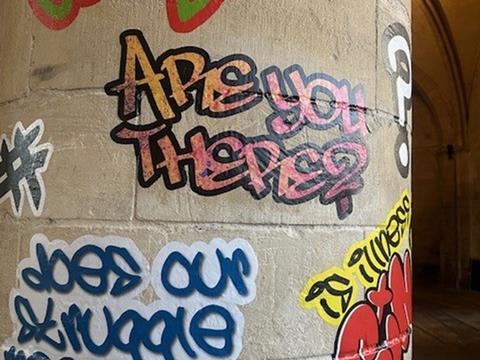
It is perhaps this ‘fake’ feeling that has exacerbated the negativity. You can hate a piece of art while still believing it says something important. But many will have come to a cathedral service seeking comfort, hope, meaning. Others will have paid £18 to admire the cathedral’s beauty and history. What does gaudy graffiti questioning God’s existence add to either experience?
The Dean of the Cathedral believes it “intentionally builds bridges between cultures, styles and genres and in particular allows us to receive the gifts of younger people who have much to say and from whom we need to hear much.”
Is some of the frustration found online because the church is now offering questions and doubts, when what people are seeking is confidence and full-fat faith? The graffiti-art asks “Are you there?” “Do you regret your creation?” If one of the world’s most important pilgrimage centres now asks questions, rather than points people to answers, then the writing is indeed on the wall for our church.
Graffiti used to be radical. Whether this new use of it is an unbecoming stunt or genius marketing, it feels like doubt is normal – and faith itself is radical.





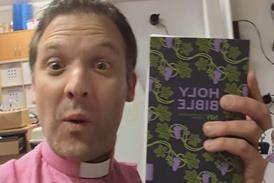





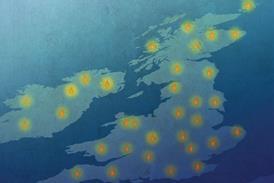



























2 Readers' comments